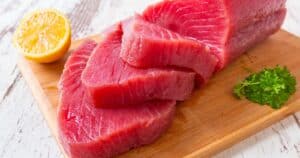Have you ever wondered how that paper-thin, savory seaweed wrap is made for your favorite sushi rolls? As a Japanese cuisine enthusiast, I used to think nori sheets came ready-made from the grocery store. But it turns out there’s an intricate cultivation and production process that starts in the ocean and ends on your plate.
Nori seaweed, as it turns out, comes from a red algae species called Porphyra, including Porphyra Yezoenis and Porphyra Tenera. The story begins with the early germination process, where oyster shells attach nori spores to nets that are submerged into the sea. Over a 3-month growth period, the nets are cultivated and harvested multiple times during cool weather. This cycle repeats almost monthly throughout the harvest season.
Once cultivated and harvested, the nori is dried, graded for quality, and roasted for consumption. The seaweed then heads to a production facility to be cleaned, minced, and blended into a mixture. This mixture gets poured into molds, fan-dried, and sponge pressed before going through a drying machine. Finally, the sheets move into a roasting machine for that perfect crunch and taste.
The result is a crispy, salty, and slightly nutty nori with a unique umami flavor. We typically eat it dry and use it to wrap sushi, complemented by vinegared sushi rice.
Curious to learn more about how this flavorful seaweed makes its way to your plate? Keep reading for a deep dive into the fascinating process behind sushi’s staple wrapping!
What is Nori Seaweed?
Nori seaweed, the consumable dark greenish-black seaweed sheets used to roll sushi, is made from a red algae species called Porphyra, including Porphyra Yezoenis and Porphyra Tenera. It grows in cold, shallow ocean waters and gets its name from the Japanese word “nori” meaning seaweed.
Nori is loaded with vitamins and minerals. It contains protein, vitamins C, A, E, K, B6, and B12. It’s also rich in iodine, manganese, thiamin, riboflavin, folate, pantothenic acid, sodium, calcium, iron, magnesium, zinc, and copper. This healthy sea vegetable packs a nutritious punch!
Now let’s explore how nori makes its journey from ocean waters to your sushi roll.
Nori Cultivation
The nori farming process starts with the early germination period. Oyster shells are used to attach nori spores to nets that are then submerged into the ocean. This allows the seaweed to grow naturally in a process called cultivation.
The cultivation period lasts around 3 months as the nets remain immersed in cool ocean waters. To maximize yields, new nets are installed almost monthly during the harvesting season. This cycle repeats to continue nori production.
Nori farmers pay close attention to weather patterns during cultivation. Typhoons and large storms can destroy entire nori crops. Therefore, ideal conditions for nori growth include temperatures between 10-20°C and mild ocean currents.
Harvesting Nori
Once the nori has finished growing on the cultivation nets after about 3 months, it’s ready for harvest. The timing here is key – farmers monitor the crop to harvest at peak freshness.
Harvest typically occurs from November to March when nori reaches maturity. Farmers bring up the underwater nets and remove the nori by hand.
After harvest, the raw nori undergoes processing right away to lock in nutrients and flavor. The seaweed gets transported to a production facility.
Nori Production
The nori production process turns the freshly harvested seaweed into the paper-like sheets we all know and love. Here are the key steps:
Cleaning: First, the raw nori gets thoroughly washed to remove debris and impurities from the ocean.
Mincing: Next, the clean nori gets minced into small fragments that break down the seaweed.
Blending: The nori fragments then get blended into a smooth, viscous paste or purée.
Pouring: The nori purée gets poured into flat molds that are then moved to drying areas.
Drying: The nori-filled molds sit in a temperature and humidity-controlled room. Here, rotating fans blow air to slowly dry the nori.
Pressing: Once semi-dried, the sheets go through a press machine to smooth and compress them into final nori sheets.
Roasting: Finally, the pressed nori sheets are roasted at high heat, which enhances flavor and gives nori its crispy texture.
Packaging: The finished nori sheets are packaged for distribution to grocery stores, restaurants, and more.
How Nori is Used
The nori that emerges from the production line is a crispy, salty, and slightly nutty seaweed with a unique umami flavor. We typically eat it dried as-is or use it to wrap sushi rolls.
To roll sushi, place a nori sheet shiny-side down and spread seasoned sushi rice over it. Add your fish or ingredients, then roll it up with a bamboo mat. The nori’s crisp texture perfectly contrasts the soft rice and fish.
Nori also makes appearances in snacks, soups, and salads. It can be crumbled over dishes as an herb or toasted until crispy as a garnish.
The most classic sushi nori pairing is with vinegared rice. Rice vinegar adds tartness that balances the savory seaweed. Other common nori rolls are:
- California Rolls: Crabmeat, avocado, cucumber, and nori
- Spicy Tuna Rolls: Chili tuna, cucumber, and spicy mayo inside nori
- Tempura Rolls: Fried shrimp, avocado, cucumber, and nori
- Veggie Rolls: Carrots, zucchini, and cucumber wrapped in nori
The Takeaway
Nori seaweed takes quite a journey from ocean waters to your sushi rolls! This nutrient-packed sea vegetable starts with cultivation on underwater nets. After growing for months, it gets harvested by hand. Through extensive processing, nori transforms into the paper-thin sheets we know. Its unique flavors and textures make nori an integral part of Japanese cuisine.
The next time you dig into sushi, take a moment to appreciate the intricate craft behind nori. It continues traditions thousands of years old and connects us to the gifts of the sea. Now that you know how it’s made – enjoy your sushi even more!





